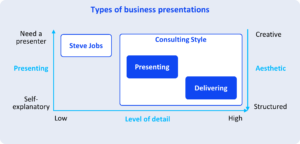Discovering the Mysteries: A Dive into the Universe of Rich Consulting Presentations

Table of Contents
Creating business presentations requires careful consideration, especially for big consulting firms. Typically, consulting PowerPoint presentations or decks are used for two reasons: presenting information and delivering important documents. Often, this leads to content-heavy presentations that aim to balance thoroughness with ease of understanding.
So, is it possible that despite the apparent overcrowding of consulting presentations, there is a systematic approach or reasoning behind it? In this article, we investigate what makes these types of presentations effective despite containing a lot of information and lacking a minimalist aesthetic. We will explore the reasons behind extensive blocks of text and data on slides and whether they help deliver impactful presentations.
Two Types of Business Presentations
Presentations play a vital role in the realm of business, taking on varying formats and serving a number of objectives. Their primary goal is to tell a story that informs, activates, inspires, persuades, etc. while effectively conveying clear takeaways, presenting compelling insights, and captivating the audience through an engaging narrative.
We distinguish two styles of business presentations that hold significant importance and relevance:
Steve Jobs style
The first style is commonly referred to as the “Steve Jobs style.”
These large keynote presentations, often seen at events, conferences, and investor pitches, involve the speaker standing on a stage and presenting to a large audience, for instance, to introduce a new product being launched.
So, what sets these presentations apart? Well, they often feature minimal visual elements, with only a few pictures or words on the slides. What is specific here is that these presentations are intended to be presented. They are designed for a large stage, emphasizing the need for a presenter to stand in front of the screen, effectively explain and provide context, and elaborate on the content displayed. It’s an example of one-way communication, and typically the presenter has a lot of credibility (CEO, Head of product line, etc.).
Keynote Example: Steve Jobs Introduces The iPhone (Apple)
Of course, Steve Jobs’ style has become well-known and is often considered the standard for business presentations. However, this style is quite different from the consulting style of PowerPoint presentations. If this seems obvious to you, you may wonder what the consulting style of presentation design looks like.
Consulting style
Unlike conferences or keynote decks that tend to place emphasis on creating an attractive visual representation, consulting presentations prioritize substance over style. The primary goal is to offer valuable information and insights rather than focusing solely on creating a creative design and an impressive visual experience for the audience.
Typically, consulting presentations are created for more formal audiences, for instance, C-level executives or board members of a company or organization. These presentations are characterized by their heavy content and extensive use of data and supporting details. And indeed, what’s probably also very interesting is that these presentations are often not even presented; they are well-structured and self-explanatory.

So, consulting presentations can be used for both presenting information and delivering essential documents. Here’s how consultants use them:
First, to present information – Consultants rely on PowerPoint decks to clearly convey complex ideas, findings, and recommendations to their clients. The presentation includes slides with visually appealing charts and graphs showcasing, for example, market trends, competitive analysis, consumer insights, etc. The consultants use these slides as visual aids to guide their discussion, explaining each slide in detail, highlighting key points, and answering questions from the client.
In addition, consulting PowerPoint decks serve as comprehensive deliverables that encapsulate crucial information, such as reports or recommendations, which can be shared with clients or internal teams. These decks are self-explanatory and include comprehensive plan proposals. They allow stakeholders to review the plans at their own convenience, without the need for a presenter.
The slides within this presentation should be thoughtfully organized, inclusive of distinct headings and concise bullet points, facilitating effortless navigation even when reviewing key takeaways independently. So, how does the structure of these slides help the client process a significant amount of information as efficiently as possible?
Effective consulting presentation
A consulting presentation tends to have a lot of information and data, and it can be hard for clients to grasp the key insights right away. So, when building consulting slides, it’s especially important to make sure they’re structured in a way that makes them clear, insightful, and engaging. The goal is to make the presentation as easy as possible for the audience to understand and guide them through the different layers of the slides so they can process a lot of information as efficiently as possible.
Effective consulting slide structure
An essential aspect of any consulting slide is its ability to effectively communicate information, and a key way to accomplish this is through a logical structure. The design composition of the slide should not provide a sense of disorder or imbalance and make the viewer solve a subconscious problem. According to Gestalt theory, the human brain subconsciously interprets visuals in a very specific way so that we can make use of them. Generally, people read slides from top to bottom and left to right, so organizing the content in a way that supports this flow is crucial. Starting with a clear title allows the audience to grasp the overall message of the slide, while the subsequent details and supporting points provide additional context. So, if someone just reads the slide titles and ignores all the content, they should get the gist of it. And at the same time, they have all the details in one place if they need them.

Typically, consulting slides are created to convey a story, with each slide delivering a unique message, and the most effective presentations have a narrative thread that runs through the titles of the slides. Thus, weaving a compelling narrative is the cornerstone of delivering an effective consulting presentation.
All consulting firms employ two important concepts, the SCQA Framework and the pyramid principle, which transform dry presentations into persuasive stories with clear narratives:
The SCQA framework
Which stands for (Situation, Complication, Question, Answer), allows you to craft a story around the information you are trying to present. It provides context and explains to the audience why they should care. This framework is particularly useful when consultants are using presentations to present information.
The Pyramid principle
Involves communicating information by starting with the main idea and then providing supporting details. This approach ensures that the audience understands exactly what you are trying to convey and how you have reached your conclusions. The pyramid principle is highly effective when consultants are using presentations to deliver important documents.

5 Secrets for Creating Effective Consulting Slides
Every slide in a consulting presentation needs to be self-explanatory. And this, of course, requires a higher level of detail, often a higher level of text, for these presentations to stand up for themselves. The important thing is that the insights are clear and interesting, even if there is a lot of information and detail.
We will unveil five secrets to help you construct compelling consulting slides that tell a story, provide key takeaways, and engage your audience from start to finish.
Secret 1: Nail the Title
The title of your slide plays a critical role in summarizing its content and key takeaways. It should encapsulate the main message and provide a glimpse into the insights it offers. By crafting concise and attention-grabbing titles, you set the stage for the audience to understand the slide’s purpose and capture their interest right away.
Secret 2: Guide the Reader
To effectively guide your audience through your presentation, follow the pyramid principle. Start with the highest level of the idea or main concept and gradually delve into supporting details. This logical progression allows the audience to comprehend your message effortlessly, ensuring a smooth flow of information.
Secret 3: Add Visuals
Visual elements are powerful tools for enhancing the processing speed of information. Incorporate charts, graphics, icons, or relevant pictures to bring your data to life in a creative and visually appealing way. These visuals provide a mental boost, making it easier for your audience to grasp complex information quickly.
Secret 4: Annotate Your Data
To highlight the insights within your slide, employ annotations that guide the audience’s attention. Annotations can include color coding, arrows, boxes, or text callouts, drawing focus to important points and key takeaways. Go beyond presenting raw data by interpreting and explaining its significance. Show the audience what the data on the slide means and provide context to help them connect the dots. This secret is what is going to make the difference between a good slide and a great slide.
Secret 5: Clean and Format Slides
Designing visually appealing slides involves two crucial steps. Firstly, add labels, navigators, sources, footnotes, and other relevant details to ensure transparency and credibility. Secondly, meticulously align and format each element of your slide, verifying that everything is properly placed and visually harmonious. This attention to detail elevates the overall professionalism and impact of your presentation.
To sum up, consulting presentations serve a specific purpose in the business world, focusing on delivering valuable information and insights rather than prioritizing visual aesthetics. These content-heavy presentations are often used to present complex ideas, findings, and recommendations to clients, as well as serve as comprehensive deliverables. Despite their extensive use of data and text, effective consulting presentations can be structured in a way that allows clients to understand and process information efficiently.
The key to creating an impactful consulting presentation lies in its logical structure. By organizing slides with clear titles and supporting details, consultants can guide the audience through the information effectively. Weaving a compelling narrative throughout the presentation enhances its effectiveness, utilizing frameworks such as the SCQA framework and the pyramid principle to transform dry presentations into persuasive stories with clear narratives.
By crafting presentations that are self-explanatory, well-structured, and insightful, consultants can effectively deliver valuable information, engage their audience, and meet the unique needs of formal and discerning stakeholders.
Sources:
https://medium.com/lessons-from-mckinsey/the-pyramid-principle-f0885dd3c5c7
https://corporatefinanceinstitute.com/resources/career/scqa/
https://www.theanalystacademy.com/how-to-create-effective-presentations/